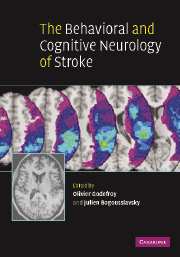Book contents
- Frontmatter
- Contents
- Contributors
- Preface
- 1 Evaluation of cognitive and behavioral disorders in the stroke unit
- Motor and gestural disorders
- 2 Motor and gestural disorders: Abnormal movement and motor behavior
- 3 Gestural apraxia
- Aphasia and arthric disorders
- Hemineglect, Anton–Babinski and right hemisphere syndromes
- Agnosia and Bálint's syndrome
- Executive and memory disorders
- Behavioral and mood disorders
- Dementia and anatomical left/right syndromes
- Index
- References
2 - Motor and gestural disorders: Abnormal movement and motor behavior
Published online by Cambridge University Press: 10 October 2009
- Frontmatter
- Contents
- Contributors
- Preface
- 1 Evaluation of cognitive and behavioral disorders in the stroke unit
- Motor and gestural disorders
- 2 Motor and gestural disorders: Abnormal movement and motor behavior
- 3 Gestural apraxia
- Aphasia and arthric disorders
- Hemineglect, Anton–Babinski and right hemisphere syndromes
- Agnosia and Bálint's syndrome
- Executive and memory disorders
- Behavioral and mood disorders
- Dementia and anatomical left/right syndromes
- Index
- References
Summary
Introduction
Focal brain lesions can induce several types of abnormal involuntary movement (AIM): dystonia, chorea, hemiballism, tremor, myoclonus, parkinsonism, and asterixis for example (Bhatia and Marsden, 1994; Lee and Marsden, 1994). The most frequent cause is stroke, followed by tumor, trauma, anoxia, vascular malformation, or multiple sclerosis. For some causes (and for stroke in particular), AIM can occur immediately after the brain lesion (for example, hemiballism during the acute phase of the stroke (Destée et al., 1990) whereas initial motor deficit may improve or be recovered rapidly. However, in other situations, AIMs (e.g. dystonia) emerge following a long period (a few months or years) of stable motor impairment (Marsden et al., 1985; Scott and Jankovic, 1996). AIMs can also be subdivided into transient (hemiballism, often in the acute phase) and persistent (dystonia, tremor, etc.). Whatever their timescales of appearance or disappearance, AIM may be the main symptom of stroke. This induces a delay in diagnosis or even a lack of knowledge of the specific diagnosis, since for the same underlying cause, the type of AIM can be quite different. This problem is sometimes clinically evident when the AIM is intense (hemiballism) or, in contrast, very moderate and focalized (asterixis). It is clear that a delay in diagnosis may have unhelpful consequences in terms of the patient's clinical and therapeutic management.
- Type
- Chapter
- Information
- The Behavioral and Cognitive Neurology of Stroke , pp. 15 - 35Publisher: Cambridge University PressPrint publication year: 2007

